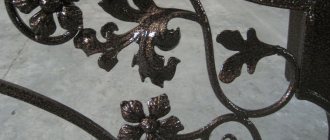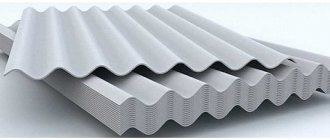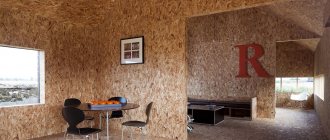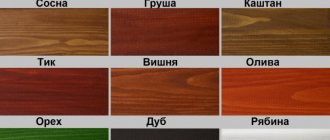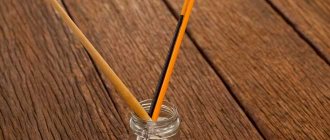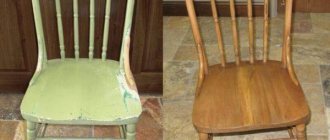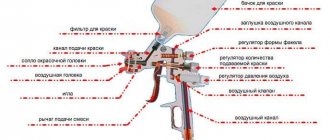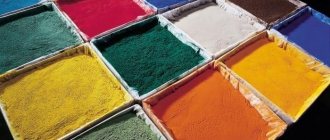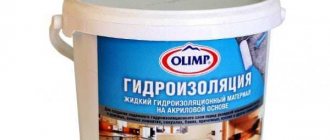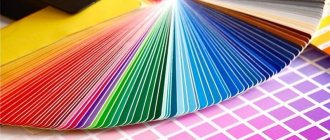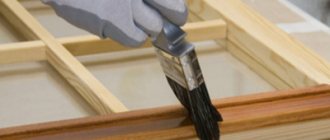Fiberglass wallpaper is a universal material for finishing walls and ceilings of any room. Previously, they were considered an office option, but the growing variety of textures, patterns and painting techniques have made it possible to use them in the design of living rooms.
The main advantage of the material is the ability to be repeatedly painted in different shades. To ensure that the properties of glass wallpaper are not lost, it is necessary to select high-quality paint and apply it according to technology.
Characteristics of glass wallpaper as a finishing material
Fiberglass wallpaper is made from special glass. It is melted, drawn into threads, woven and pressed. The result is a strong and durable material that differs from many other types of wallpaper in the following properties:
- Low fire hazard class. Does not ignite or burn.
- Antistatic effect. There is less dust settling on it.
- Air permeability. This property prevents the formation of mold and mildew on the surface of the plaster.
- Environmental safety. The fabric is made from natural materials without harmful chemical additives.
- Ability to hide minor defects. However, the wall must be leveled, since the thickness of the sheets will not be able to cover large differences in the plane.
- Additional surface reinforcement. Prevents the appearance of cracks and protects against external mechanical damage.
- Reduced paint consumption. The composition is applied in a thin, even layer, exactly as indicated on the package.
Due to the possibility of repeated staining, glass wallpaper can last more than 30 years. They are not afraid of moisture, are not attractive to fungus and mold, and do not absorb odors. Glass wallpaper is suitable for all rooms, even kitchens and bathrooms with high humidity.
Note! Fiberglass and fiberglass (painting canvas) are different types of materials. The first ones have a textured pattern and are intended for finishing. The latter are used to level the surface for puttying and painting; they do not have decorative qualities.
Typically, the color of glass wallpaper is gray-white. Any shade can be applied well to it. Whether to paint them or not depends on the design of the room. If you are satisfied with the original color, you don’t have to cover them with coloring compounds. But in this case, there is a possibility of wear at the ends of the strips and partial unraveling of the fabric. Therefore, professionals consider this stage mandatory. In addition, the paint holds the fibers together and does not allow them to separate.
The most common relief designs that are applied to glass wallpaper are: herringbone, matting, diagonal, diamond. There are also more rare ones - floral prints, ornaments, geometric shapes.
Is it necessary to paint glass wallpaper?
Typically fiberglass wallpaper is white and is usually painted.
You don’t have to paint it if you are happy with their appearance and they fit your interior in this form, but white wallpaper that needs to be painted may look unpresentable.
You should not paint glass wallpaper in bright colors, as this color will quickly get boring and you will have to repaint it.
They also produce colored glass wallpaper - they can also be painted, but this is not necessary.
Choosing paint for glass wallpaper
Not all types of interior paints are suitable for painting glass wallpaper. Firstly, it is necessary to preserve the properties of canvases, such as environmental friendliness, fire safety and breathability. Secondly, glass wallpaper is an expensive material; if you cover it with a cheap composition, then the money spent on purchasing rolls will be wasted.
Experts recommend using water-dispersion paints. They dry quickly, do not smell, do not emit toxic substances and are breathable. They penetrate well into the fibrous structure of fabrics and provide high-quality adhesion.
Special compositions are produced for textured and fiberglass wallpaper. Their consistency is more liquid, which allows them to better preserve the surface topography.
Water-dispersion paints differ in composition, namely, in the type of binder; accordingly, they are used for different types of premises.
Butadiene styrene (latex)
Latex paints are suitable for the bathroom and rooms facing the north side of the house. They are moisture resistant, so they can be washed repeatedly. The only limitation in their use is well-lit rooms. When exposed to ultraviolet radiation, the coating acquires a yellowish tint.
Acrylate
A universal option for any premises. The composition is easily tinted. Resistant to ultraviolet radiation and high humidity. Dries quickly. This is the optimal solution for painting glass wallpaper.
Polyvinyl acetate
Suitable only for dry rooms: bedroom, children's room, living room. They do not tolerate moisture, so it is not recommended to wash them. This option is used when it is necessary to reduce repair costs, since the cost of polyvinyl acetate paints is lower than acrylate and latex paints.
Top 9. TEX
Rating (2021): 4.30
222 reviews taken into account from resources: Yandex.Market, Otzovik, Petrovich.ru, Leroymerlin.ru
Inexpensive paints for wallpaper of all types. The Tikkurila sub-brand produces affordable and good quality paints and varnishes. They are compatible with glass wallpaper, as well as non-woven and vinyl-based wallpaper.
- Characteristics
Country Russia
- Official website: teks.ru
- Price range: from 194 to 6500 rubles.
Russian-Finnish manufacturer of finishing materials. A subsidiary of the Tikkurila brand. The range includes paints for non-woven, vinyl, paper wallpaper and glass wallpaper. The most popular lines among users are Pro and Universal. Both series have washable paintwork materials. Although budget products from TEX are cheaper, their consumption is quite high. And this is due to low coverage: to get a normal color you will have to coat the surface at least 3 times. True, if you apply paint to a flat, light surface, then the consumption will be more economical. But you will have to put up with the spraying of paintwork materials during the work process and carefully cover the furniture and floor, since the material is quite difficult to wash off after complete drying (4 weeks).
Advantages and disadvantages
- Many shades for tinting
- Universal paints and varnishes
- Budget cost
- The actual consumption of all coatings is higher than stated
- Materials splash during painting
Selecting a shade
What color to paint glass wallpaper is determined mainly by personal preferences. Since technical standards provide for any shades. But there are some rules, they are dictated by the practical experience of builders:
- For light and translucent shades, it is necessary to carefully prepare the base even before wallpapering. The surface should have a uniform color, without spots or streaks.
- For the first coloring, you should not choose a bright or dark shade. If you get tired of it, painting it lighter will be problematic.
- Colors can and should be combined so that the walls do not look monolithic and too formal.
For the rest, you should be guided by the design of the room, the degree of its illumination, the color of the furniture and the functional purpose of the room.
Advice! You can buy colored paint or white and paint it yourself.
Choosing a color for cladding – bright or calm?
On the market of facing materials, paints are presented in a wide range of colors. Some of them are already ready for use, others must first be mixed with colors. When choosing a shade, we recommend relying on your own design preferences, as well as taking into account the style of decoration. At the same time, professionals have developed some recommendations for choosing paint that will help you choose the most suitable material.
It is not recommended to choose too bright and catchy shades for painting. Sooner or later, you will get tired of a too bright interior and will only start to cause irritation, as a result of which you will have to repaint the walls in calmer and more neutral shades.
If you want to make the interior catchy, it is better to use several shades in coloring. The background color should be calm, and small amounts of rich tones can be used as an accent. This solution will not only diversify the interior and bring to life your own bold design solutions, but will also make the decorated rooms visually more spacious.
The color and pattern of the glass wallpaper must be fully consistent with other objects in the room’s design, including decorative elements, furniture, all kinds of accessories and decorations. Any discrepancy will negatively affect the perception of the interior and may lead to the immediate need to repaint the surfaces.
If you decide to paint glass wallpaper using stencils, then it is best to choose small images that will decorate the room and emphasize its style and attractiveness. Too massive drawings will make the room visually less spacious and, in general, may negatively affect its aesthetics.
Unusual ways of coloring and combining shades
Monochrome painting is not always appropriate in residential areas. You can create an atmosphere of comfort, change the proportions of space and zone a room by using different paint application techniques. Simple types can be completed independently; more complex ones require skill and experience - they are best entrusted to specialists.
Painting glass wallpaper with stencils
The use of stencils allows you to apply any design or pattern to the surface of glass wallpaper. You can purchase a ready-made stencil at construction centers or make an outline on the wall using masking tape.
Performance:
- Painting wallpaper in the main color. When using stencils, it is better to make the walls plain.
- Marking the drawing with masking tape.
- Painting with a roller (for large designs) or a foam sponge (for working out small details).
It is necessary to apply the design using a stencil after the base color has dried. Using this technique, you can decorate boring wallpaper at any time after painting.
The use of borders for painting walls
Borders are ready-made decorated strips. They can be made of fiberglass or any other material. With their help, they zone the room and adjust the proportions.
The horizontal arrangement of borders visually lowers a ceiling that is too high. Vertical, on the contrary, lifts. The shades of the areas between the dividing stripes can be combined.
Execution steps:
- Surface marking. Determining the areas where the curbs will be located. The gap between the wallpaper sheets should be slightly less than the width of the dividing strips.
- Coloring glass wallpaper. This stage is performed strictly before gluing the borders.
- Gluing borders after the paint has dried.
Important! Borders are not glued to the embossed surface of glass wallpaper. Only on a bare wall.
Application of glaze
Azure is a special composition that allows you to create a light, heterogeneous coating against a background of bright color, slightly muting the main shade. It is applied to the entire surface or to sections, forming a large pattern, without clear lines.
Coloring stages:
- Application of the main color. It is worth choosing a bright one so that the effect is more pronounced.
- Application of decorative glaze. For this purpose, use a wide flat brush. Movements should be jerky and multidirectional.
- Composition distribution. 10–20 minutes after application, the mixture is leveled with a rubber spatula.
The shade of the azure should be different from the main color. It is possible to apply a second layer of the composition if the effect is not bright enough.
Squeegee staining
For this technique, a special glaze coating (water-based decorative varnish) is used. It is translucent and takes longer to dry than water-based paints. This method allows you to create an unusual effect - the surface relief becomes more pronounced and voluminous.
Stages of work:
- The walls are painted in the main color. It is best to choose a rich, bright shade.
- After drying the first layer, a glazing composition is applied.
- Immediately wipe it with a slightly damp sponge or smooth it with a rubber spatula to remove paint particles on the convex parts of the relief.
Thus, the glaze composition remains only in the recesses, and the main color appears on the protruding parts.
Top 7. AURA
Rating (2021): 4.40
132 reviews taken into account from resources: OZON, Otzovik, Petrovich.ru
The best paints for non-woven wallpaper The brand, according to reviews, produces affordable and high-quality paints and varnishes. They are ideal for painting non-woven wallpaper.
- Characteristics
Country: Sweden
- Official website: eskaro.com/by/brendy/aura/
- Price range: from 242 to 4000 rubles.
A subsidiary brand of the Swedish holding Eskaro Group AB, specializing in sub-premium finishing materials. Paintwork materials from Aura are truly of high quality: they are applied evenly to non-woven wallpaper, dry quickly and form a durable coating. Lines designed for roll coverings include: Interior Golfstrom, LuxPro 3/7/12, Interior Satin and Interior Fjord. In addition to paints, the brand produces wallpaper varnish Aqua Lack 20, which can be used as a final protective coating. Paints can be applied either with a spray gun or by hand, they do not flow, and the layers dry within 1-2 hours. But paint and varnish materials are not suitable for all surfaces. Due to the average hiding power, to obtain the desired shade on a dark base, the material will have to be applied in 3-5 layers.
Advantages and disadvantages
- Paints do not bleed during application
- Paintwork materials can be applied to a light-colored substrate in 1-2 layers
- The assortment includes finishing varnishes for wallpaper
- Materials do not cover dark colors
- Possible color mismatch
Technology of painting glass wallpaper in the main color
When painting glass wallpaper, you must adhere to the general rules for carrying out repair work. Close windows and doors to the room, protect the floor and furniture from paint splashes. Painting should be done at room temperature - 18-22 degrees and humidity up to 40-50%. Under such conditions, the paint will dry gradually and evenly. You should not use heating devices to speed up the process, as this will dry some areas faster and others slower - this can lead to stains and streaks.
Surface preparation
Painting is carried out no earlier than 72 hours after gluing. The glue under the wallpaper must dry thoroughly before the next stage of processing is done.
The surface of the glass wallpaper must be primed - this improves adhesion to the paint layer, reduces the consumption of the finishing coating, smoothes out loose fibers and binds dust particles. For processing, you should use a special primer or a weakly concentrated solution of wallpaper glue. It is allowed to dry, then they begin to apply paint.
Tools
To apply paint, use a spray gun or a long-haired roller - they paint the relief best. For hard-to-reach areas: corners, junction lines with the floor and ceiling, you will need a narrow brush.
If the paint needs to be tinted before use, you should stock up on a construction mixer to thoroughly distribute the dye throughout the mass.
Application
Handling a spray gun requires experience and skill; non-professionals are better off using a roller. Staining is carried out according to the following scheme:
- Stir the paint before use.
- Pour a little into the cuvette.
- Dip the brush and remove excess paint from it.
- Paint corners and joint lines. It is important to ensure that the composition fills all the recesses on the glass wallpaper.
- Dip a roller into the paint and roll it along the top of the container so that the composition is distributed evenly throughout the coat.
- Paint the main part of the walls. Moving from the ceiling to the floor. A fresh strip should always overlap the previous one by a few millimeters. You will have to press lightly on the roller to paint the cavities.
It is best to start work from the corner, where the edge painted with a brush ends. During application, you should not take breaks, as a stripe will appear in the place where the process is stopped. Therefore, it is necessary to paint the entire room in one go.
Glass wallpaper is painted in two layers. The second is applied 12 hours after the first, according to similar instructions.
Preparatory stage
How to paint glass wallpaper and are there any features or nuances? Many people ask these questions. It's simple. Painting such wallpaper is easy. You can use a regular paint roller with lint. The tools used are the same as for regular wall painting. It is convenient to work with a special plastic tray with a mesh. This will eliminate smudges. First, all corners, top lines near the ceiling and bottom lines near the baseboard are processed with a wide brush. Then the first coat of paint is applied - the primer. This is considered a preparatory stage. After drying, the process of painting the corner areas is repeated. The second, final painting is being carried out. For painting, if you have the skill, you can use a spray bottle. This is more convenient, saves a lot of time, and does not require additional tools. The main thing is skill and accuracy. As in the first option, when working with a roller, all clean areas and objects (objects, baseboards) should be protected with film. This is interesting: is it possible to paint non-woven wallpaper?
Plastic bath
Pile roller
Surface care after applying paint and repainting
Features of glass wallpaper care are determined by the type of paint applied. If it is latex or acrylic, then it can be washed using non-abrasive detergents. It is no longer possible to remove dirt from polyvinyl acetate paint. To increase the service life of latex-based compositions, direct sunlight into the room should be limited.
In case of severe contamination, fading or wear, the paint is renewed. You can repeat the procedure an unlimited number of times. But with each layer the relief of the glass wallpaper will be smoothed out. The optimal number of stains is 5.
Advice! Glass wallpaper with a pronounced relief can be painted more times.
Fiberglass wallpaper is a high-quality and durable coating for walls and ceilings. Their use for decoration allows you to change the design and color scheme of the room at any time, repeatedly and quickly.
Top 10. Dufa
Rating (2021): 4.20
169 reviews from resources taken into account: Yandex.Market, Leroymerlin.ru
The colors always match those stated. All types of materials from Dufa, according to reviews, do not change shade after drying. The colors retain their brightness throughout the entire service life.
- Characteristics
Country Russia
- Official website: dufa.ru
- Price range: from 171 to 5000 rubles.
A domestic brand with European roots. It produces wallpaper paints with bright and saturated shades, and the final colors completely coincide with the declared ones. The manufacturer's product range includes the Europlast 3/7 Interior and Velvet lines. The paints have excellent hiding power: they completely replace the color of the base. The layers dry in 2 hours and are completely dry in 24 hours. If it weren’t for the unpleasant odor that appears over time after applying paintwork, Dufa would have taken 1st place in the ranking. And the reason for the specific “aroma” of a cat’s surprise lies in the incompatibility of the composition with wallpaper glue. But with which one, the manufacturer does not yet know. Therefore, the problem does not occur for all users, and it occurs only when using material from the Velvet line.
Advantages and disadvantages
- Bright colors
- Good hiding power
- Materials are applied without smudges, stains or splashes
- Inflated prices for some paints and varnishes
- Unpleasant odor upon contact with wallpaper glue
Top 3. FINNCOLOR
Rating (2021): 4.55
77 reviews taken into account from resources: Petrovich.ru, OZON, Otzovik, Yandex.Market
Long service life of the coating The surface of wallpaper painted with FINNCOLOR paints remains bright and resistant to wet cleaning for 10 years. This is the largest figure in the collection.
- Characteristics
Country Russia
- Official website: finncolor.ru
- Price range: from 299 to 4500 rubles.
Finnish brand Tikkurila. The range includes moisture-resistant, washable acrylic-based coatings. The brand produces the Oasis Wallpaper line especially for all types of wallpaper. The material emphasizes the texture of the base and is easily distributed. The FINNCOLOR range also includes universal paint Oasis Kitchen&Gallery. But it is more suitable for painting glass wallpaper. Drying time: up to 4 weeks. After this time, the coating becomes durable and resistant to wet cleaning. Judging by the reviews, there are no particular problems with the use of paints, but still some complain about the instability of paints and varnishes to moisture. Problems with coating washability are most often associated with improper care of the treated surface and non-compliance with drying technology.
Advantages and disadvantages
- Paints perfectly hide unevenness
- The range includes materials with antifungal additives
- Paintwork materials are tinted using Tikkurila equipment
- Products are manufactured using Finnish technologies
- Some paints and varnishes are washed off after complete drying.
See also:
- 10 Best Paint Rollers
